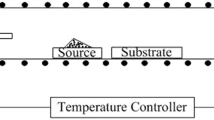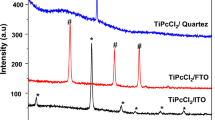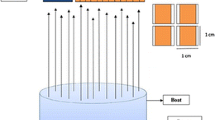Abstract
The resistance and transmittance of Ti-oxide thin films sputtered on quartz substrates were studied. The electrical and optical properties can be changed by varying the percentage of O2 introduced during the sputtering. The lowest resistivity for the sputtered Ti-oxide thin film was 2.30 × 10−2 Ω cm for 12.5% O2, which was obtained after annealing at 400°C in ambient oxygen. The results of x-ray photoelectron spectroscopy (XPS) curve-fitting indicate that the Ti-oxide thin film contained both Ti2O3 and TiO2 phases during deposition. The Ti2O3 phase was transformed into the stable TiO2 phase during annealing. The Ti2O3-TiO2 phase transformation initiated the substitution reaction. The substitution of Ti4+ ions in the TiO2 phase for the Ti3+ ions in the Ti2O3 phase created the free electrons. This Ti2O3-TiO2 phase transformation demonstrates the potential mechanism for conduction in the annealed Ti-oxide thin films. The transmittance of the annealed Ti-oxide thin films can be as high as approximately 90% at the 400 nm wavelength with the introduction of 16.5% O2. This result indicates that the annealed Ti-oxide thin films are excellent candidates for use as transparent conducting layers for ultraviolet (UV) or near-UV light-emitting diode (LED) devices.
Similar content being viewed by others
References
C.H. Yang, S.C. Lee, T.C. Lin, and W.Y. Zhuang, Mater. Sci. Eng. B 134, 68 (2006).
C. Guillard, D. Debayle, A. Gagnaire, H. Jaffrezic, and J.M. Herrmann, Mater. Res. Bull. 39, 1445 (2004).
N.R. Mathews, E.R. Morales, M.A. Cortés-Jacome, and J.A. Toledo Antonio, Sol. Energy 83, 1499 (2009).
A. Yildiz, S.B. Lisesivdin, M. Kasap, and D. Mardare, J. Non-Cryst. Solids 354, 4944 (2008).
H.P. Deshmukh, P.S. Shinde, and P.S. Patil, Mater. Sci. Eng. B 130, 220 (2006).
T. Miyata, S. Tsukada, and T. Minami, Thin Solid Films 496, 136 (2006).
D. Mardare, N. Iftimie, M. Crisan, M. Raileanu, A. Yildiz, T. Coman, K. Pomoni, and A. Vomvas, J. Non-Cryst. Solids 357, 1774 (2011).
J.C.C. Fan and J.B. Goodenough, J. Appl. Phys. 48, 3524 (1977).
H. Natsuhara, K. Matsumoto, N. Yoshida, T. Itoh, S. Nonomura, M. Fukawa, and K. Sato, Sol. Energy Mater. Sol. Cells 90, 2867 (2006).
C. Rath, P. Mohanty, A.C. Pandey, and N.C. Mishra, J. Phys. D Appl. Phys. 42, 205101 (2009).
E. McCafferty and J.P. Wightman, Appl. Surf. Sci. 143, 92 (1999).
Y.C. Liang and Y.C. Liang, Appl. Phys. A 97, 249 (2009).
H. Sedghi-Ghamchi, A. Hassanzadeh, M. Talebian, and H. Mahmoodi-Chenari, Physica B 389, 329 (2007).
Author information
Authors and Affiliations
Corresponding author
Rights and permissions
About this article
Cite this article
Liu, Y.S., Lin, Y.H., Wei, Y.S. et al. Conductor Formation Through Phase Transformation in Ti-Oxide Thin Films. J. Electron. Mater. 41, 166–171 (2012). https://doi.org/10.1007/s11664-011-1822-7
Received:
Accepted:
Published:
Issue Date:
DOI: https://doi.org/10.1007/s11664-011-1822-7




